May 31, 2018 —
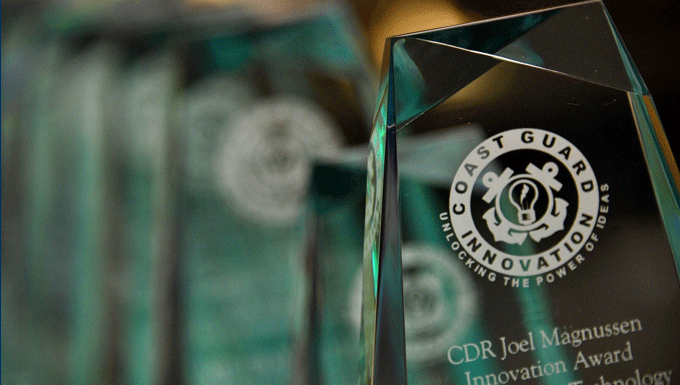
The Coast Guard honored 12 Coast Guard members for ideas that have had a significant impact on the service’s operations with Capt. Niels P. Thomsen Innovation Awards, presented May 31, 2018, during the Senior Leadership Conference held at Coast Guard Headquarters in Washington, D.C.
“These people have embraced the spirit of change and fearlessly advanced forward,” said Rear Adm. Michael Haycock, assistant commandant for acquisition and master of ceremonies. “It’s such a pleasure to recognize them today.”
He told the Coast Guard senior leadership gathered at the conference: “The workforce is using innovation to get things done. They’ve transformed policy, used state of the market tools, and saved us millions of dollars.”
The Innovation Awards are presented annually to members of the Coast Guard workforce who have used their talents, creativity and collaborative efforts to discover ways to make the service better, through increased efficiency or productivity or other process improvements. The awards are named after the Coast Guard innovator who developed the “chain stopper,” which dramatically improved the safety of buoy tending operations. They are awarded in the areas of science or technology; operations or readiness; administration, training or support; culture change; and management.
This year’s Innovation Awards also included a Distinguished Public Service Award for Greg Sadetsky, who provided volunteer support for Sector Houston-Galveston during Hurricane Harvey in August 2017. When the hurricane knocked out Sector Houston-Galveston’s connection to the Coast Guard computer network, Sadetsky’s custom software was used to coordinate more than 700 aircraft sorties that resulted in the safe evacuation of more than 1,700 people in dire need of assistance.
“It was an absolute game changer,” Haycock said. “His software dramatically improved situational awareness.”
At a luncheon honoring the award recipients, Rear Adm. Joseph Vojvodich, who co-chairs the Coast Guard Innovation Council, thanked the winners for their dedication.
“It really takes great effort and energy to solve a problem, to figure out how to do something better, smarter, faster or less costly. Because you are so linked to the service, you are really able to understand the problem,” said Vojvodich.
Vojvodich acknowledged that it is often believed that “innovation is all about the idea,” but the reality is that it takes “a lot of hard work to make that idea a reality.”
“Our new commandant, Adm. Karl Schultz, has called on us to accelerate toward the future,” said Cmdr. Andy Howell, who heads the Coast Guard’s Innovation Program. “These brilliant members of the workforce have pushed us along in many important areas, from personnel management to the use of social media.”
This year’s winners:
Science or Technology
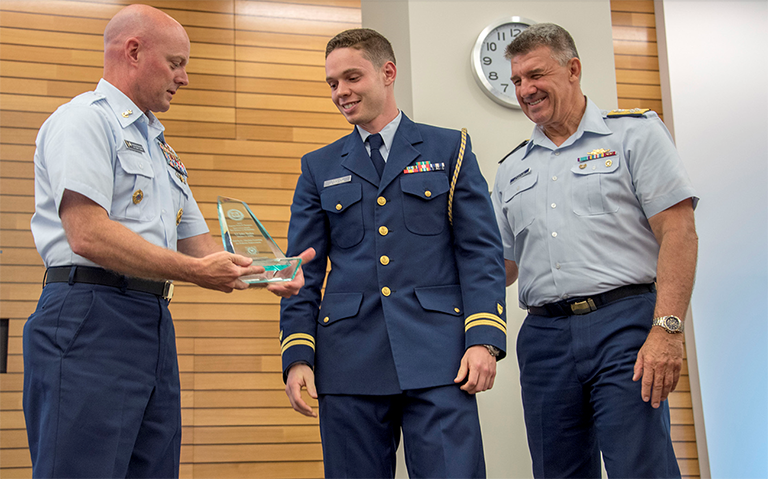
Master Chief Petty Officer Jason Vanderhaden presents the Capt. Niels P. Thomsen Innovation Award in the Science or Technology category to Lt. Jake Taylor for a software application called FishTactic. Waiting to offer his congratulations is Adm. Karl Schultz, now Coast Guard commandant. U.S. Coast Guard photo by Petty Officer 2nd Class Loumania Stewart.
FishTactic, Machine Learning for Fisheries Enforcement – Lt. Jake Taylor
In collaboration with District 17 Intelligence, Taylor created FishTactic, a software application to synthesize 11,400 electronic positions, 10 aviation sighting reports, 3,300 fisheries permits, 4,000 electronic landing tickets, 150 National Oceanic and Atmospheric Administration observer reports, 1,200 previous Coast Guard boardings, and 12 lookout list vessels to enable operational decisions that maximize living marine resources mission execution. FishTactic now includes a predictive component, coupling the data with a machine-learning algorithm that distinguishes high precedence fisheries with a 90 percent success rate. Looking to the future, machine learning and artificial intelligence will soon enhance many Coast Guard missions, and FishTactic may be remembered as one of the first forays into this emergent technology.
Taylor is currently assigned to District 17 Response Enforcement Branch in Juneau, Alaska, where he serves as a D17 living marine resources analyst and the aide to the D17 commander in Juneau. He supports projects to enhance LMR intelligence. He has served four years in the Coast Guard.
Operations or Readiness
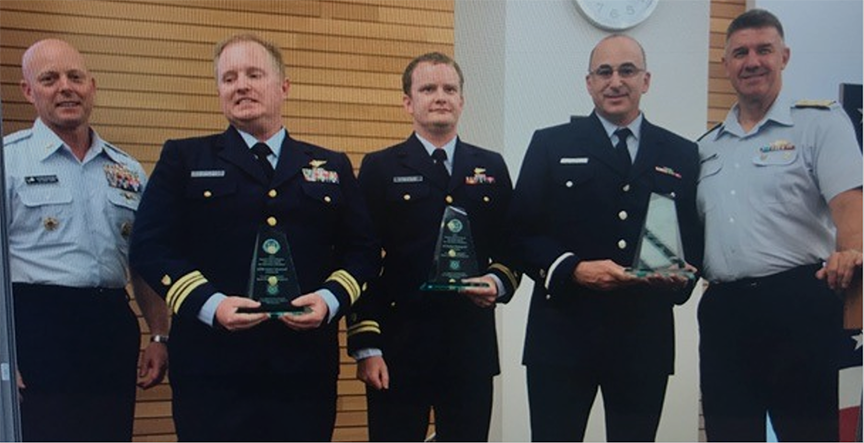
The winners of the Capt. Niels P. Thomsen Innovation Award in the Operations or Readiness category, from left, Lt. Cmdr. Andrew Greenwood, Lt. Nathan Shakespeare and Auxiliarist David Hoffman, with Master Chief Petty Officer Jason Vanderhaden and Adm. Karl Schultz, Coast Guard commandant. U.S. Coast Guard photo by Petty Officer 2nd Class Loumania Stewart.
Use of Cloud Computing For Disaster Response Case Management – Auxiliarist David Hoffman, Lt. Nathan Shakespeare and Lt. Cmdr. Andrew Greenwood
Shortly after making landfall, Hurricane Harvey knocked out Sector Houston-Galveston’s connection to the Coast Guard network. Hoffman and Shakespeare quickly created a simple but effective mission management platform using mobile-friendly cloud-based tools. Shortly after, Greenwood obtained permission to use Geosuite, a geographic mission management tool to track hurricane response activities. These related efforts created an unprecedented level of mission collaboration and were lauded as game-changers by responders at all levels, as well as District 8 leadership.
Hoffman is currently an active member of the Coast Guard Auxiliary Flotilla 6-10 D8CR, where he takes part in communications, public awareness, and surface and air patrols. He has been a member of the Auxiliary for over 10 years. Shakespeare is currently assigned to the Aviation Training Center in Mobile, Alabama, where he serves as an MH-65D standardization pilot/flight examiner. He has served for 14 years. Greenwood is currently assigned to Force Readiness Command as an aviation training manager at Coast Guard Headquarters where he is responsible for the oversight of all enlisted and officer formal aviation training. He is responsible for assisting the Office of Aviation Forces and the Office of Aeronautical Engineering on new initiatives, developing training to support new acquisitions and upgrades to existing aircraft, and managing 104 Class “C” Schools and supporting attendance for over 5,000 students a year. He has served for 16 years.
Administration, Training or Support
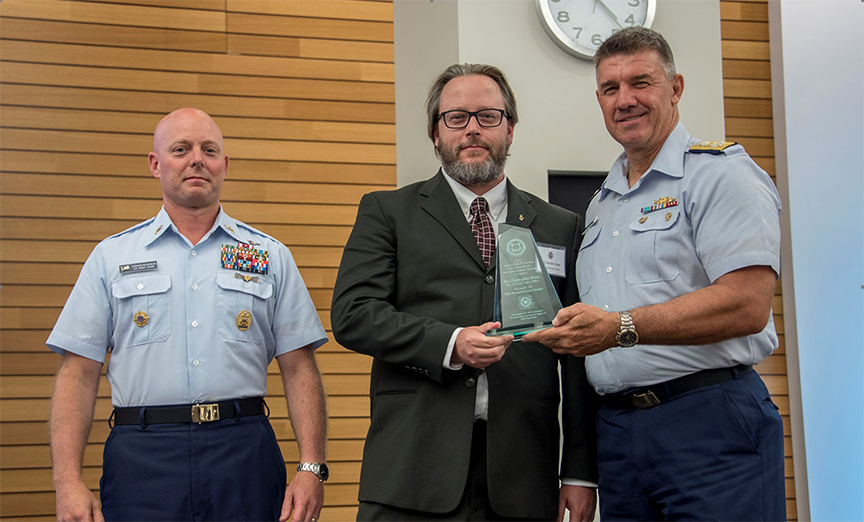
Adm. Karl Schultz, Coast Guard commandant, presents the Capt. Niels P. Thomsen Innovation Award in the Administration, Training or Support category to Christopher Slater, who developed a flight management system simulator for HC-27J training. Also pictured is Master Chief Petty Officer Jason Vanderhaden. U.S. Coast Guard photo by Petty Officer 2nd Class Loumania Stewart.
No-Cost HC-27J Flight Management System Simulator – Christopher Slater
The HC-27J program was using expensive simulation time ($2,000 per hour) to train new students to program the aircraft’s flight management system. Slater developed an emulator in Adobe Animate, usable on workstations and tablets, which emulates the FMS functions taught in the course. With over 40 pilots trained to date, and each with access to the emulator, this endeavor has saved $2.5 million. Most importantly, trainee execution time for this fundamental skill has dropped from 50 minutes to 7.5 minutes during their first flight simulator session.
Slater is currently assigned to HC-27J Asset Project Office, Elizabeth City, where he serves as the lead instructional systems specialist, performance systems team lead. He served 10 years of active duty and has nine in civil service.
Culture Change
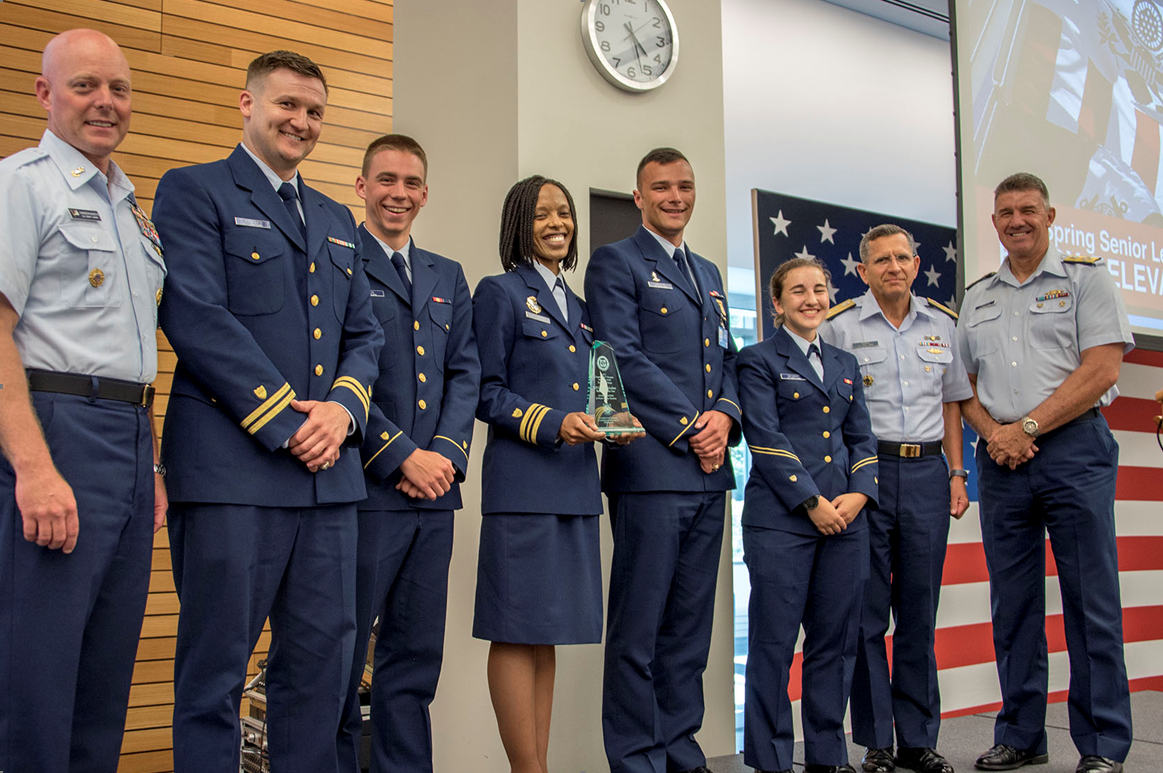
Flanked by Master Chief Petty Officer Jason Vanderhaden and Adm. Karl Schultz are the winners of the Capt. Niels P. Thomsen Innovation Award in the Culture Change category, from left, Lt. Christopher Verlinden, Cadet 2nd Class Evan Twarog, Lt. Cmdr. Kimberly Young-McLear, Cadet 2nd Class Reid Wirgleb and Cadet 3rd Class Clara Beckert. U.S. Coast Guard photo by Petty Officer 2nd Class Loumania Stewart.
Leveraging Social Media for Disaster Response Operations – Lt. Cmdr. Kimberly Young-McLear, Lt. Christopher Verlinden, 2/c Reid Wiegleb, 3/c Clara Beckert, 1/c Gabrielle Auzenbergs and 2/c Evan Twarog
The Coast Guard Academy was the first Coast Guard entity to systematically monitor and analyze social media for a disaster response operation. More than 100 Academy cadets, mentored by two faculty members, not only monitored social media during Hurricanes Harvey and Irma, but also supplied professional mapping products created in ArcGIS for the Coast Guard Incident Command System social media search-and-rescue representatives. The team created highly detailed mapping products displaying the concentration of distress calls, delivering enhanced situational awareness to operational commanders every four hours.
Young-McLear is currently a permanent faculty member at the Coast Guard Academy in the Engineering Department. Her duties include teaching, advising, researching, and other services to prepare future cadets to be commissioned officers. She has been serving for 15 years. Verlinden is currently a military rotating faculty member in the Science Department at the Coast Guard Academy and teaches courses in Geospatial Information Systems.
Cmdr. Joel Magnussen Innovation Award for Management
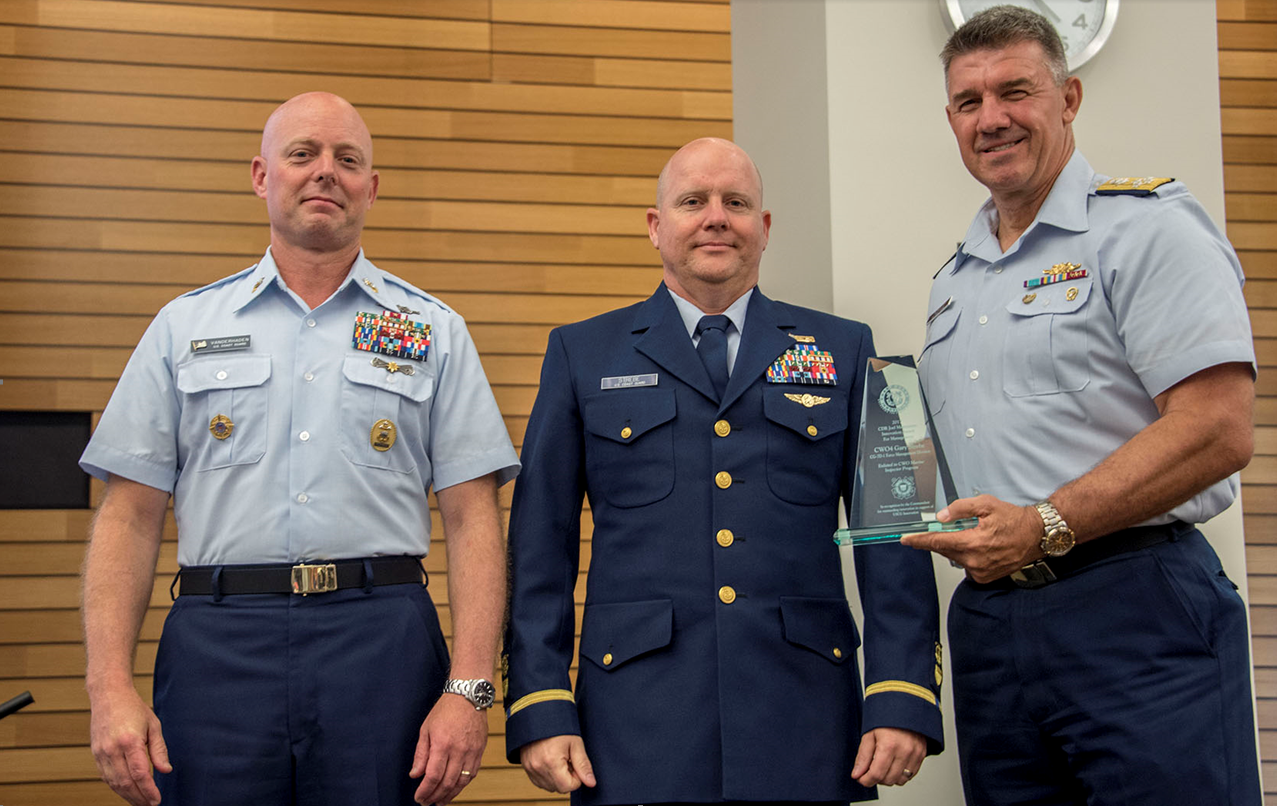
Master Chief Petty Officer Jason Vanderhaden, Chief Warrant Officer Gary Strebe and Adm. Karl Schultz; Strebe received the Cmdr. Joel Magnussen Innovation Award for Management for a program that allows high-performing enlisted personnel to apply to become CWO marine inspectors. U.S. Coast Guard photo by Petty Officer 2nd Class Loumania Stewart.
Enlisted to Chief Warrant Officer Marine Inspector Program – Chief Warrant Officer Gary Strebe
The Coast Guard Human Capital Strategy Implementation Plan directed leaders to identify courses of action to address critical staffing needs within the Marine Inspection Program. Chief warrant officer retention has been a long-standing issue for the prevention community, especially considering the three-year training investment for a fully qualified inspector. Strebe was the prime action officer for the Prevention Workforce Integrated Product Team and the Sector Missions Training Advisory Sub-Council, working with Personnel Service Center to create a new program that allows high-performing enlisted personnel to apply to become CWO marine inspectors. The initial pilot of the program received an impressive 483 applicants for 10 positions, along with resounding positive feedback from field and senior leaders. This pilot program directly fulfilled commandant strategic direction and is poised to grow proficiency and increase bench strength within the prevention workforce.
Strebe is currently assigned to the Specialty Force Manager for the Marine Safety Specialties and Office Chief of CG-7D-1 Force Management Division at Coast Guard Headquarters where he serves as the supervisor for the boatswain’s mate, diver, gunner’s mate, maritime enforcement, marine science technician and operations specialist rating force master chiefs. Strebe has been serving with the Coast Guard for over 30 years and will retire on July 31, 2018.
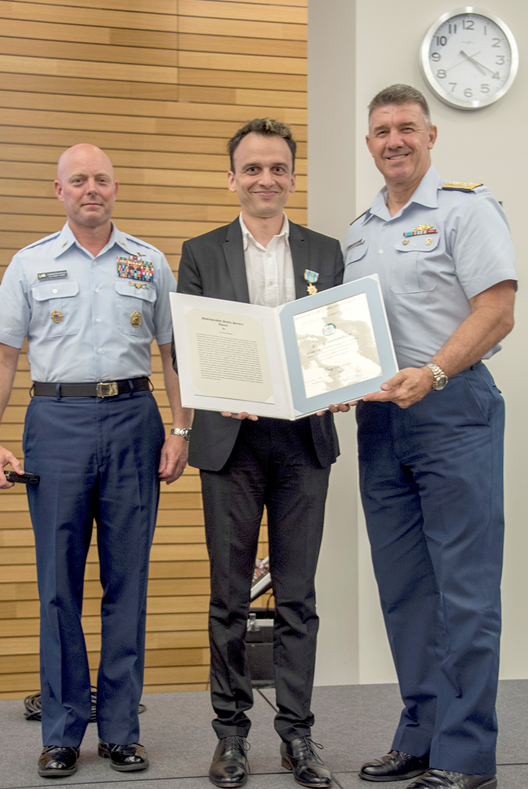
Greg Sadetsky was honored for Distinguished Public Service for a software solution that helped with rescue efforts during Hurricane Harvey. Presenting the award are Master Chief Petty Officer Jason Vanderhaden and Adm. Karl Schultz. U.S. Coast Guard photo by Petty Officer 2nd Class Loumania Stewart.
Distinguished Public Service Award – Greg Sadetsky
Sadetsky’s custom software solution during Hurricane Harvey allowed for geographic display of case information, dramatically improving the situational awareness and deficiency of search-and-rescue efforts. He directly contributed in the evacuation of individuals trapped inside their homes with rising flood waters, urgent transportation of women in labor, critical patient transfers between hospitals, medical evacuation of burn victims, and blood deliveries to resource-constrained hospitals. Sadetsky’s volunteer work enabled Coast Guard responders to quickly and efficiently help hundreds of people who were in grave danger.
The Coast Guard Innovation Council was chartered to assess and provide strategic guidance on emerging technologies, missions, gaps, challenges and requirements. It is made up of key leaders from across the service’s directorates and geographic areas and is co-chaired by the deputies for Operations and Mission Support. The Coast Guard Innovation Program seeks to foster an organization capable of continuous innovation and learning. It resides in the Office of Research, Development, Test and Evaluation and is the executive agent for Innovation Council activities.